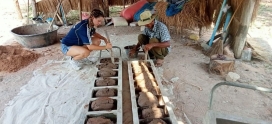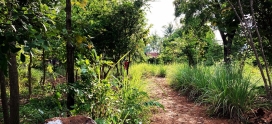Week 6 in Myanmar
There are several joys of getting older in medicine. First there are more stories to tell the ever-rotating batches of juniors, usually relating either to hours on call, which are prefixed with ‘When I was an SHO’ or to cases seen when it’s ‘I remember a patient with’.
Then there’s the freedom to care less who you irritate and what you say, knowing either your colleagues or management are just waiting for that day they pop along to your good-bye party and say fare-thee-well to an old man who seemed embedded into the foundations of the hospital and had passed his ‘best-before’ date and therefore are prepared to put up with your barbed criticisms. Luckily for me the latter was not the case, and with a quick commercial plug for Manchester, a better unit and crew of sprightly colleagues you would be hard pushed to find. I suppose my favourite is the junior’s always laughing at my jokes through respect and thinking ‘he’s losing it’ because they’ve heard them numerous times before. Here it’s a refreshing leveller. Everyone has stories to tell, often from conflict zones or desperate conditions, when the anecdote is more likely to be prefixed with ‘Life was so bad that’ or ‘I remember eating’ and informing you of some gut-churning unsavoury food. But at least I can proudly report (vegetarians look away) that I have now eaten pig colon and what I was informed were deep fried testicles from the same poor beast. Another first is having a great evening supporting the ‘reds’: no, not my beloved Manchester United, but the Myanmar international football team in their battle against India. So, for any of you thinking I’m unstintingly devoting my time 24/7 to helping the needy, I’m embarrassed to disappoint you. But to use that terrible word, there is a great ‘camaraderie’ between the volunteers to enjoy life when the opportunity arises and to be part of it is a great privilege (picture).
Last night I went to an art auction in aid of raising funds for a charity called Phoenix (http://phoenixmyanmar.net/). Now the paintings were priced a little beyond an NGO volunteer’s range at $1200 but I learnt a lot about the stigma attached to being a PLHIV in Yangon.
I now know I can travel safe when I take a taxi anywhere because all the taxi drivers must be HIV tested to get a license. Now, they are hardly a high-risk group, mostly chewing betel nut driving with the precision of a brain surgeon cutting through the cerebral cortex, and racing after you to give you your wallet back if you left it in the car.
The Phoenix organisation was set up to provide care to those poor souls who had been churned out onto the street by their family because of their HIV and therefore, in the event of falling sick and needing hospital admission, were barred entry because: rule one is you need a carer to be admitted. So basically, get HIV, get disowned, get sick, get refused hospital entry, get dead. Things are better now but where the stigma is painful to see, this is a brave and to be supported organisation. Only 45 UK visitors have visited their website ever: have a look. The same day I attend a meeting at the stately WHO headquarters home in Yangon and it was music to my ears to hear again that jargonese we must learn to succeed in medicine such as patient pathways, bottom-up management and the famous blue-sky thinking (now I prefer blue-sky sunblock).
Still I heard there are around 100,000 patients with HCV ‘warehoused’ awaiting their HCV viral load test (of an estimated 1.5 million in the country): wow. Sometimes a David can be more efficient than the Goliath though: thanks to kind sponsors, MAM (the charity I work for) plan a one-stop hepatitis show – viral load, FibroScan, USS, and treatment with sofosbuvir and daclatasvir for those co-infected. But it’s a continuous fight for sponsorship and I’m amazed at the effort expended to bring this about.
Switching again, Efavirenz has been knocked off every Western guideline as the ‘king of the castle’ in favour of the integrase inhibitors. Out here, the patients don’t have that luxury and it’s efavirenz first-line and nevirapine second-line, and yes, no-one stops efavirenz. I naively thought that it’s because back home we’ve made too much of a fuss about the side effects, but don’t you believe it, they get the same bad dreams as anyone else! It reminds me of the early days of therapy when regimens were unpleasant, demanding to take, and brimming with side effects and underlies the resoluteness of the human to stay well at all costs whatever the cost to quality of life. And it’s necessary because of the massive rate of TB co-infection (picture of patient with 6×6 cm abdominal mass presumed TB) as without it, for you budding pharmacokineticologists, it’s double dose lopinavir/r with your rifampicin! And medical friends back home are essential and I thank all of you who have provided advice when I plead for help).
So medically as to what I’m managing to achieve I think I’m starting to find my feet. Educational events are more frequent – today it’s dealing with fever (the commonest presentation), performing a FibroScan (donated), a quick run through of the new HCV DAA’s (sofosbuvir and daclatasvir donated through a sponsor) and a reminder about HIV resistance. Interestingly the genotypes seen here are mainly 3 and 6. Turn out is usually good but the three-line whip is out. It’s slightly paradoxical to be talking about high-tech Western stuff such as FibroScans and DAA’s at the same time as trying to get a viral load for HIV introduced.
Nevertheless, the challenge in the clinics is trying to maintain high quality medicine when there are few of the tests you need, your clinical skills are challenged by the fact that the design of the clinics is open to keep the temperature down and the noise emanating from the enormous variety of never-serviced motorised vehicles is deafening; and turn-around time for investigations is frequently several days and as I’ve alluded to extremely limited. But you’ll all know that when it comes to high value tests, finding the organism is tops. So, my list of ‘mission impossible’ tasks when I nip back to Blighty for Easter is to try and bring back the skills etc. for introducing induced sputum collection, bone marrow biopsy, simple microscopy stains, and learning the basics of abdominal USS. Before I go, I plan to introduce protocols for the work-up of fever, cough and investigation and management of anaemia. And we all learn from each other but running through clinical skills is vital. That all sounds a little excessive but as they say ‘better to try and fail than not try at all’; oh dear, forgive me for all this syrupy stuff.
Of course, many of these are standard, slightly irritating, commitments for you in the UK. However, suddenly you realise they are essential and need introducing here as well. So, watch out clinics because I have plans for audit, mortality, and CXR meetings and, most importantly for the present, supporting the docs in choosing and presenting cases at the 2-day Green Shoots/MAM educational event at the beginning of May. On another tack and leading me to my next plan of getting VL for HIV introduced, I lectured to the Obstetric doctors in one of the government hospitals yesterday. I was amazed to hear, because of the unavailability of VL tests for mums at 36w (or at any other time), all go on to have an elective CS. All mums are kept in for 5-days post ECS and there is a complication rate of at least 5%: another no brainier in managing resources.
Oh dear, I’ve rabbited on. I’ll stop there and nip down for a bit of pig colon.




